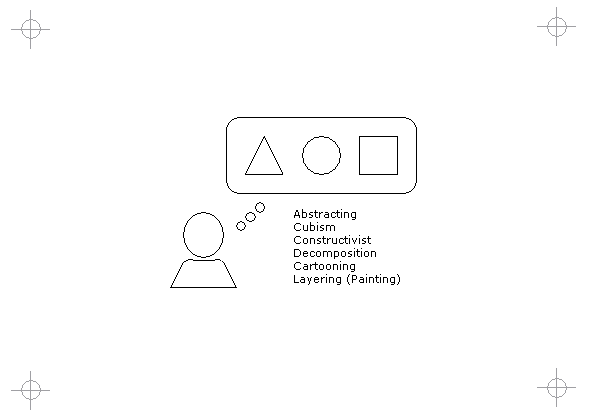|
Diagram
|
|
|

|
|
Title
|
|
|
Art Patterns
|
|
Building Architecture
|
|
|
At the Bauhaus, painters provided constructivist thinking in architecture. Cubist and abstract art aid in abstraction. Creative thinking can be developed using less traditional art forms such as photography, cartoons and multimedia. Black and white photography and cartoons help to simplify visually complex images. Applying layers of paint provides an iterative pattern for construction - each layer providing increasing clarity and detail.
|
|
Architecture Intensive Disciplines
|
|
|
Art patterns provide patterns for thinking. These patterns relate to construction and can be used in solving design and construction problems. Not only is software development an abstract activity but there are similarities in the process of construction. Art thinking is also directly applied to designing human interfaces and graphics is playing an increasing role with web based development.
|
|
Case Study A: Large Corporate IT
|
|
|

|
|
|
I use UML notations in my technical diagrams. I also try and use geometric shapes and UML like graphics when communicating ideas. A number of slide presentations, documents and web pages contained such diagrams. Where possible the shapes are used to convey visual meaning - for instance a triangle can convey the notion of hierarchy and a circle is ideal for conveying cycles, recursions and wholes. Rectangles foster the notion of containment. Another example maybe that a wholistic view of a problem can be denoted by a circle while each solution proposed can be noted by a rectangle.
The web development team employed people with a background in graphic design and journalism. This was very effective in creating a well designed and thought out "look and feel". The challenge faced was no different to other organisations around the world - how to bridge the gap between media centric web development and software engineering. Web developers with a graphic design background are not usually trained in structured programming and many software engineers regard themselves as "artistically challenged". This "brave new world" requires a fusion of graphic artist and software engineer - plus the humanities of "human centered design".
|
|
Case Study B: Small Commercial Team
|
|
|

|
|
|
I avoided the use of diagrams in this environment because I wanted to attempt story telling and the use of metaphors as prescribed in Extreme Programming (XP).
Slight aesthetic modifications were made to replace large "clip-art" graphics with more logical and less resource intensive "ornamentation". The longer term solution was to revamp the interface and apply simpler and logical graphics. For instance, layouts and icons could be standardised to allow the user to learn the function of the application through a visual language or set of patterns.
|
|
|